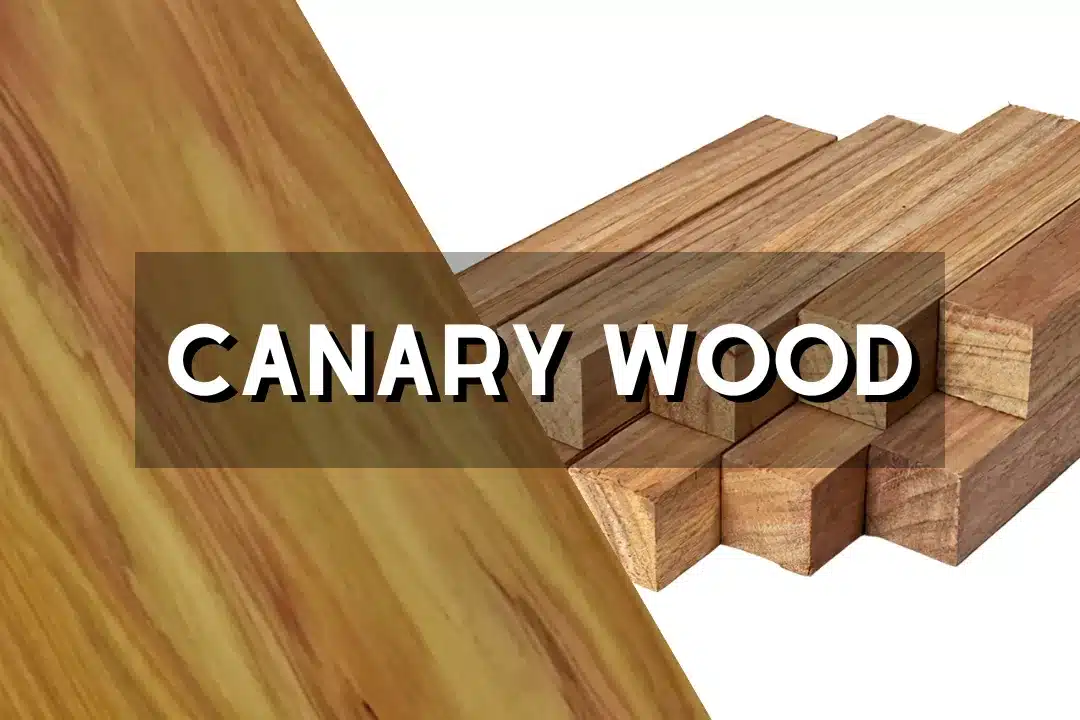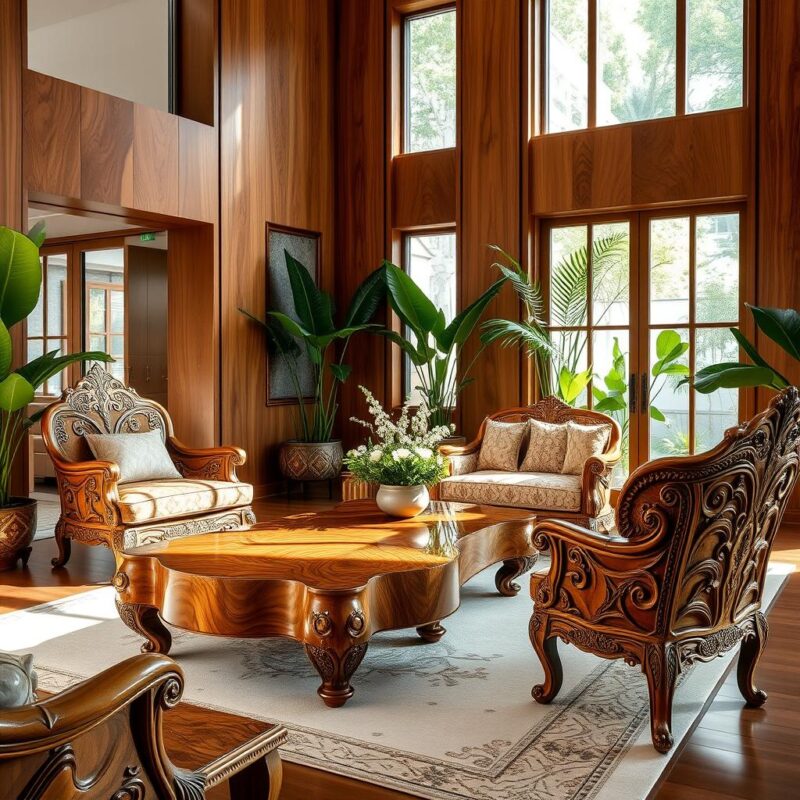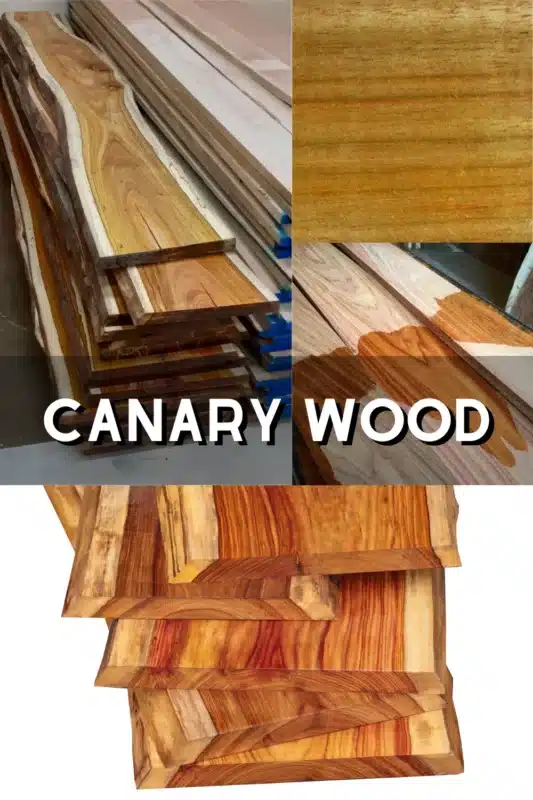
The Beauty and Benefits of Canary Wood: 8 Things You Should Know

Did you know some dragon’s blood trees can take up to 100 years to grow fully? This shows how rare and valuable exotic hardwoods like canary wood are. Coming from Central and South America, this wood is loved for its beauty and strong timber properties.
We will explore eight special features of canary wood. These make it stand out for luxury furniture and home decor. Discover why the vibrant yellow-toned wood is so popular, from its bright colors to its long-lasting strength.
Table of Contents
What is Canary Wood?
Canary wood is a stunning hardwood known for its beauty and practical uses. It comes from the lush forests of Central and South America. Woodworkers love it for its unique look and feel.
Origin and Availability
This South American wood grows everywhere, from Panama to southern Brazil. It’s mainly found in Venezuela and Colombia. The trees can grow up to 100 feet tall and have trunks up to 3 feet wide.
It’s easy to find canarywood on the market. You can find it in various sizes and sometimes as blanks for turning.
Physical Characteristics
Canary wood is known for its beautiful colors. It ranges from pale yellow to rich reddish-brown. This adds depth to any project.
The wood is medium to heavy, weighing about 52 lbs/ft³ when dry. Its specific gravity shows it’s strong but not too hard to work with.
It’s very hard, with a Janka hardness of 1,520 lbf. This means it’s resistant to denting and wear. It’s also very durable and stiff, making it great for many uses.
Working with This unique woodworking choice is generally easy. But, be careful with irregular grain patterns as they can cause tearout.
| Property | Value |
|---|---|
| Average Dried Weight | 52 lbs/ft³ (830 kg/m³) |
| Specific Gravity | 0.65 – 0.83 |
| Janka Hardness | 1,520 lbf (6,750 N) |
| Modulus of Rupture | 19,080 lbf/in² (131.6 MPa) |
| Elastic Modulus | 2,164,000 lbf/in² (14.93 GPa) |
| Crushing Strength | 9,750 lbf/in² (67.2 MPa) |
| Shrinkage Rates | Radial: 2.4%, Tangential: 5.6%, Volumetric: 8.4% |
| Rot Resistance | Very durable |
The Distinctive Color Palette
Canary wood comes in many colors, appealing to many tastes. It can be soft yellow or vibrant reddish-brown. These colors make it popular for furniture and decorations.
Color Variations from Pale Yellow to Reddish-Brown
Canary’s colors fit well with many styles. It goes from pale yellows to deep reddish-browns. This makes it a favorite among woodworkers and designers.
How Aging Affects the Color
As the canary ages, its color changes. Light and air bring out warmer tones. This makes the wood more decadent and more unique.
| Age of Wood | Initial Color | Color After Aging |
|---|---|---|
| 0-5 Years | Pale Yellow | Subtle Yellow Warmth |
| 5-10 Years | Golden Yellow | Deeper Yellow with Hints of Red |
| 10+ Years | Light Reddish-Brown | Rich Reddish-Brown |
Unique Grain Patterns
Canarywood is famous for its beautiful and detailed grain designs. These designs make it a favorite among wood lovers and craftspeople. Each piece has unique grain patterns that are different, adding to its beauty. This variety is not just for looks; it also helps furniture makers and designers.
Eye-Catching Grain Designs
This richly grained species is known for its amazing designs. You might see spirals, lines, and spots that show off its natural beauty. These designs make the wood perfect for custom projects or decorative items. The patterns in canary wood are seen as art, leaving a strong impression on viewers.
The Impact of Grain Patterns on Aesthetics
Every grain pattern in canary wood changes its wood aesthetics. Designers love how these patterns can be the main attraction in a room. They make any room look better, whether it’s modern or traditional. The unique grain patterns of canary wood always add elegance and class.
Durability and Strength of Canary Wood
This exotic hardwood is a top pick in the hardwood world for its durability and strength. It’s great for furniture and building projects. Its ability to resist wear and tear shows it’s reliable and versatile.
Resistance to Wear and Tear
This richly grained species is tough, handling daily use well. Its natural features make it resistant to wear, perfect for busy areas. This means furniture stays looking good and working well for a long time.
Comparison with Other Hardwoods
Canary wood is stronger than mahogany and bubinga, with a Janka hardness rating of 1,520 lbf. It’s a strong contender in durability tests. While mahogany is warm and stable, The vibrant yellow-toned timber offers unique beauty and strength.
Its high silica content makes machining tricky, but pre-drilling helps avoid splitting. This doesn’t stop it from being used in many projects, from cabinets to boats.
Workability of Canary Wood
This timber is known for its impressive workability. It’s easy to cut, shape, and finish. This makes it a favorite among woodworkers and artisans.
It has a dried weight of 52 lbs/ft³ and a Janka hardness of 1,520 lbf. This combination of strength and workability allows for intricate designs with minimal effort.
Ease of Cutting and Shaping
Canary wood works well with both hand and machine tools. Woodworkers love its minimal tear-out, even on wild-grain pieces. This makes it easy to work with and encourages creativity.
Finishing Techniques that Enhance Appeal
Finishing wood is key to showing off canary wood’s beauty. Techniques like oiling, varnishing, and staining bring out its colors and grain patterns. These methods protect the wood and make it look stunning.
| Aspect | Details |
|---|---|
| Average Dried Weight | 52 lbs/ft³ (830 kg/m³) |
| Janka Hardness | 1,520 lbf (6,750 N) |
| Rot Resistance | Very durable, resistant to decay and pests |
| Workability | Easy with mild tearout on irregular grain |
| Price Range for Turning Stock | $1.50 to $39.90 |
| Turning Stock Average Price | Approximately $9.24 |
| Veneer Price Range | $52.74 to $78.83 |
| Live Edge Slabs Price | $14.00 for 5/4 thickness |
Canary Wood in Furniture Making
Canary wood is gaining popularity for its stunning looks and practical uses in furniture. Its unique patterns and luxurious feel make it perfect for high-end furniture. This allows craftsmen to create pieces that are both beautiful and functional.
Applications in High-End Furniture
Canary wood furniture is a favorite in luxury markets because of its rich colors and durability. Designers use it in many ways, like:
- Dining tables that become the centerpiece of dining rooms
- Cabinets that add beauty and storage
- Unique decorative items and custom pieces
Its colors and grain patterns not only look great but also last long. This makes it a valuable addition to any elegant home.
Combining Beauty and Functionality
This species is perfect for furniture-making because it’s both beautiful and strong. It’s not just pretty; it’s also:
- Strong enough for daily use
- Resistant to wear and tear, lasting longer
- Easy to care for, making it practical for everyday use
This mix of beauty and practicality makes canary wood a top choice for luxury furniture. It’s loved by both homeowners and designers.

| Property | Details |
|---|---|
| Average Dried Weight | 52 lbs/ft³ |
| Janka Hardness | 1,520 lbf |
| Common Applications | Furniture, cabinetry, flooring |
| Rot Resistance | Very durable against decay |
| Sustainability Status | Not listed in CITES |
Environmental Aspects of Sourcing Canary Wood
Getting canary wood responsibly helps keep our planet healthy. It’s better than using non-renewable stuff like granite or marble. Now, we focus more on using wood that’s been certified, like FSC (Forest Stewardship Council) products.
These certifications help protect nature and stop trees from being cut down too much. This is key for a healthy planet.
Responsible Sourcing Practices
Knowing where canary wood comes from is key. Good practices mean we can keep using this wood for years to come. It also helps reduce harm to the environment.
Wood absorbs carbon dioxide, which is good for our planet. This helps lower harmful gases in the air.
The Importance of Sustainable Forestry
Using sustainable forestry keeps nature balanced. Making wood worktops uses less energy than other materials. This means less pollution and greenhouse gases.
Wood products last a long time, so we don’t need to replace them often. This saves resources and energy. More people want to buy things that are good for the planet.
Pricing and Market Trends
When looking at canary wood pricing, several factors come into play. These include availability, quality, and demand. The wood’s unique grain patterns and color also affect its cost. Knowing these details is crucial for anyone interested in buying.
Factors Influencing the Cost
Several aspects impact the pricing of canary wood:
- Density: About 38 pounds per cubic foot, it’s durable and heavy.
- Resistance: It resists decay and insects well, adding to its value.
- Shock Resistance: It’s great for flooring and construction because of its shock resistance.
- Seasoning Requirement: Kiln-drying is key for its best performance.
- Growth Rate: It grows fast, which affects its sustainability and availability.
What Buyers Should Know Before Purchasing
Before buying this timber, keep these tips in mind:
- Choose wood from trusted suppliers who practice sustainable forestry.
- Know the wood’s texture and grain patterns for both looks and function.
- Think about how you’ll use the wood, like in furniture or flooring.
- Stay updated on market trends and prices to understand its value.

Market Availability
Canary wood mainly comes from Central and South America, and the Caribbean. Its availability affects its price and demand. Knowing these trends is key for buyers.
| Factor | Impact on Pricing |
|---|---|
| Density | High density means higher price due to durability. |
| Resistance | More resistance to decay means higher value. |
| Grain Patterns | Unique designs can greatly increase price. |
| Environmental Impact | Being carbon-neutral boosts its appeal for sustainability. |
Understanding canary wood pricing and market trends helps buyers make smart choices. This ensures their investment meets their needs and preferences.
Comparison with Other Exotic Woods
When we compare canary wood to mahogany and bubinga, we see different qualities. Each wood has its own look, durability, and cost. Knowing these differences helps us choose the right wood for our projects.
Contrasting Features with Woods Like Mahogany and Bubinga
Mahogany is known for being stable and lasting long. It’s a top choice for fancy furniture. Canary wood, on the other hand, has colors that range from light yellow to reddish-brown. This makes it perfect for adding a unique touch to projects.
Bubinga is famous for its bright colors and unique grain. Like canary wood, it has interesting grain patterns. But canary wood’s grain is more varied, making it visually appealing. Both woods can last over 100 years with the right care.
Price is also a key factor. Exotic woods like canary wood are often more expensive. The cost varies based on the wood type and how easy it is to find. This helps us pick a wood that fits our budget and style.
How to Care for Canary Wood Products
Proper care for canary wood products keeps them looking great and lasting long. Knowing the right maintenance tips helps avoid common problems. Here are key tips for the best canary wood care.
Maintenance Tips to Preserve Quality
Keep canary wood away from direct sunlight to prevent discoloration. Avoid sudden changes in temperature to stop warping. Regular dusting is crucial, using a clean, damp cloth.
For deeper cleaning, a mild soap solution works well. Applying a high-quality wood conditioner every few months also helps. It keeps the finish looking good and the wood shiny.
Common Issues and Remedies
Even with good care, wood can still get scratches and fade. To fix scratches, refinish the area to match the original look. For fading, a wood polish can make the surface look new again.
Checking your wood regularly helps catch problems early. This way, your canary lumber stays beautiful and functional for a long time.
Future of Canary Wood in Home Décor
Canary wood is making waves in home décor. Its bright color and unique grain patterns are winning over designers. They’re looking to mix modern and traditional styles, and canary wood fits right in.
Designers are now using more exotic woods like canary wood. This shows a growing interest in adding a special touch to homes.
Trends in Usage and Style
Canary wood has become more popular in home décor. It’s now used in many different styles. Here are some trends:
- It’s being used in furniture like beds and nightstands, showing off its beauty and strength.
- Canary wood is also used in big pieces like dressers and dining tables. These items become the center of attention in rooms.
- It’s also being used in cabinetry and trim work. This adds a touch of class to modern kitchens and living areas.
Predictions for the Exotic Wood Market
As demand for canary wood grows, the wood market is expected to change a lot. Here are some predictions:
| Market Trend | Expected Impact |
|---|---|
| Increased Demand for Exotic Woods | More people wanting unique materials will lead to higher prices. |
| Sustainable Sourcing Practices | There will be more focus on harvesting wood in an eco-friendly way. This will ensure wood is available for the long term. |
| Growing Home Décor Styles Utilizing Exotic Woods | Exotic woods like canary wood will be used in more ways. This will bring more creativity and versatility to designs. |
Conclusion
Canary wood is not just beautiful; it’s also very useful. It’s used in making high-end furniture and musical instruments. Its colors and grain patterns make it a favorite for adding luxury to homes.
This wood is also good for the planet because it’s sourced sustainably. Knowing how to care for canarywood helps it last longer. This makes it a great choice for anyone looking to invest in quality.
This decorative hardwood summary shows that using canary wood is not just about looks. It’s also about helping the environment. Its unique qualities make it a favorite among both artists and buyers, whether for homes or businesses.
FAQs
What is the origin of canary wood?
Canarywood comes from Central and South America, mainly Venezuela and Colombia. It’s prized for its beauty and use in luxury items.
How does aging affect the color of canary wood?
As canarywood ages, its color gets deeper and richer. Light and air exposure enhance this, adding warmth and beauty.
What makes canary wood’s grain patterns unique?
Canary wood’s grain is special, with patterns like spirals and spots. This makes each piece unique and sought after.
Is canary wood resistant to wear and tear?
Yes, canarywood is strong and durable. It stands up well to daily use, making it great for furniture.
How easy is it to work with canarywood?
Working with canarywood is easy. It’s simple to cut and shape, making it a woodworker’s favorite.
What are the applications of canary wood in furniture making?
Canarywood is used in high-end furniture like tables and cabinets. Its beauty and durability make it a designer’s choice.
How can I ensure I am sourcing canary wood responsibly?
Buy canary wood from suppliers who harvest sustainably. This ensures the wood is not harming forests.
What factors influence the cost of canary wood?
The cost of canarywood depends on its quality, grain, color, and availability. Market demand also affects the price.
How does canary wood compare with other exotic woods like mahogany and bubinga?
Canarywood has unique colors and patterns compared to mahogany and bubinga. Each wood has its own appeal for different tastes.
What maintenance tips should I follow to preserve canary wood?
Keep canarywood away from sunlight and extreme temperatures. Dust it regularly and clean with a damp cloth. Avoid excessive wear.
Are there any common issues that can arise with canary wood?
Canary can get scratched or fade. Fix scratches by refinishing, and use polish to restore shine if it dulls.
What trends are emerging in the usage of canary wood?
This species is becoming popular in home décor for its beauty and unique qualities. It suits both modern and traditional styles.
What predictions are there for the exotic wood market?
Demand for exotic woods like canary wood is expected to grow. This is because people want unique furniture and décor. Sustainable sourcing is key for future availability.



